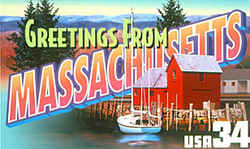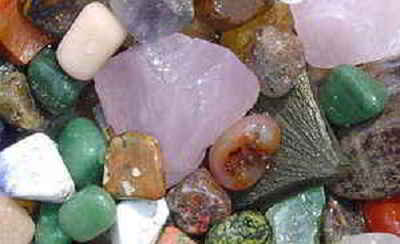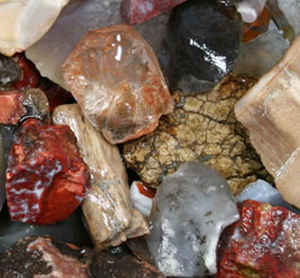
Massachusetts Symbols
Massachusetts State Explorer Rock
Dighton Rock

Adopted on May 23, 1983.
Dighton Rock was made the explorer rock of the Commonwealth on May 23, 1983.
The Dighton Rock is a 40 ton boulder, originally located in the riverbed of the Taunton River at Berkley, Massachusetts (formerly part of the township of Dighton). The rock is noted for the controversy surrounding a set of mysterious inscriptions on it. In 1963, the rock was removed from the river by a coffer dam and is under the protection of the state of Massachusetts.
Massachusetts State Explorer Rock: Dighton Rock
 In 1963, during construction of a coffer dam, state officials
removed the rock from the river for preservation. It was installed in a museum in a nearby park, Dighton Rock State Park. In 1980 it was listed on
the National Register of Historic Places (NRHP).
In 1963, during construction of a coffer dam, state officials
removed the rock from the river for preservation. It was installed in a museum in a nearby park, Dighton Rock State Park. In 1980 it was listed on
the National Register of Historic Places (NRHP).
Dighton Rock State Park
An 11-foot-high "glacial erratic" boulder known as Dighton Rock once rested on the shore of the Taunton River adjacent to this park. Covered with petroglyphs, carved designs of ancient and uncertain origin, the rock is now installed in a small museum. The museum (open by appointment) exhibits several explanations of the carvings, which range from Portuguese explorers to Native Americans.
The park, which covers 85 acres in the town of Berkley, is a popular local picnic spot because of its soft, grassy areas interspersed with mature shade trees.
Things to Know Before You Go
The park is open 7 days a week. The museum is open by appointment only" please call 508 644-5522.
Park Directions
Dighton Rock State Park is located near Fall River in southeastern Massachusetts.
From the north: Rte. 24 south to exit 10 west. Right at End of Ramp onto N. Main Street. Left on Friends St. Follow signs.
-Quote from "New England's Ancient Mysteries" by Robert Ellis Cahill, 1993
 The most controversial inscribed rock in New England is Dighton
Rock at Berkeley, Massachusetts, on the Taunton River. As early as 1677, scholars such as Cotton Mather. Dean Barkeley, and Ezra Stiles have tried
to decipher the messages chiseled into its ten foot by four foot sandstone face. Stiles was convinced that the rock was covered with ancient Phoenician
petroglyphs. Mather sent drawings of the markings to the Royal Society of London to see what they thought, but the English scientists were non-committal.
In 1837, Danish scholar Carl Rafn read Roman numerals and the name "Thorfinn Karlsefni" in the stone. Thorfinn supposedly sailed to America from Greenland
in the year 1010. In this century, Brown University professor Edmund Burke Delabarre deciphered part of the inscription on the rock to read: "Miguel
Cortereal by will of God, here Chief of the Indians," along with the date 1511 and a Portuguese coat-of-arms. Miguel Cortereal, a Portuguese navigator,
did disappear in 1501 with his crew, sailing the Atlantic in search of his explorer brother Gaspar Cortereal, who had also disappeared with his three
ship and crews the year before. Their father, Joao Vas Cortereal, traveled to "the land of the cod," thought to be Newfoundland in 1472, twenty years
before Columbus' voyage.
The most controversial inscribed rock in New England is Dighton
Rock at Berkeley, Massachusetts, on the Taunton River. As early as 1677, scholars such as Cotton Mather. Dean Barkeley, and Ezra Stiles have tried
to decipher the messages chiseled into its ten foot by four foot sandstone face. Stiles was convinced that the rock was covered with ancient Phoenician
petroglyphs. Mather sent drawings of the markings to the Royal Society of London to see what they thought, but the English scientists were non-committal.
In 1837, Danish scholar Carl Rafn read Roman numerals and the name "Thorfinn Karlsefni" in the stone. Thorfinn supposedly sailed to America from Greenland
in the year 1010. In this century, Brown University professor Edmund Burke Delabarre deciphered part of the inscription on the rock to read: "Miguel
Cortereal by will of God, here Chief of the Indians," along with the date 1511 and a Portuguese coat-of-arms. Miguel Cortereal, a Portuguese navigator,
did disappear in 1501 with his crew, sailing the Atlantic in search of his explorer brother Gaspar Cortereal, who had also disappeared with his three
ship and crews the year before. Their father, Joao Vas Cortereal, traveled to "the land of the cod," thought to be Newfoundland in 1472, twenty years
before Columbus' voyage.
 "Dighton Rock is like the rocks you see along the highways,
filled with graffiti," says Jim Whitall. "It's where everyone wanted to leave a message, and it's the first stone in America that anyone paid any attention
to. It was a bulletin-board for ancients, Native Americans, and colonials alike." The rock with the mysterious hieroglyphs was moved to dry land a
few years ago by the Commonwealth of Massachusetts and a building was built around it to preserve the inscriptions. Winter ice and constant submergence
at high tide under the Taunton River, began obliterating some of the older markings. Also, in case one of the great scholars who deciphered the stone
over the past 300 plus years is right, it's best to preserve what may be a most important piece of history. Even if the hodgepodge of scratches and
scribblings can't ever be deciphered, Dighton Rock is a unique rock of ages. Sam Morison said, "if the history of the Dighton Rock is nothing else,
it is a remarkable demonstration of human credulity. Right on, Sam!"
"Dighton Rock is like the rocks you see along the highways,
filled with graffiti," says Jim Whitall. "It's where everyone wanted to leave a message, and it's the first stone in America that anyone paid any attention
to. It was a bulletin-board for ancients, Native Americans, and colonials alike." The rock with the mysterious hieroglyphs was moved to dry land a
few years ago by the Commonwealth of Massachusetts and a building was built around it to preserve the inscriptions. Winter ice and constant submergence
at high tide under the Taunton River, began obliterating some of the older markings. Also, in case one of the great scholars who deciphered the stone
over the past 300 plus years is right, it's best to preserve what may be a most important piece of history. Even if the hodgepodge of scratches and
scribblings can't ever be deciphered, Dighton Rock is a unique rock of ages. Sam Morison said, "if the history of the Dighton Rock is nothing else,
it is a remarkable demonstration of human credulity. Right on, Sam!"
Massachusetts Law
The law designating the Dighton Roc as the official Massachusetts state explorer rock is found in the General Laws of Massachusetts, Part 1, Title 1, Chapter 2, Section 24
PART I ADMINISTRATION OF THE GOVERNMENT
TITLE I JURISDICTION AND EMBLEMS OF THE COMMONWEALTH, THE GENERAL COURT, STATUTES AND PUBLIC DOCUMENTS
CHAPTER 2 ARMS, GREAT SEAL AND OTHER EMBLEMS OF THE COMMONWEALTH
Section 24 Explorer rock of commonwealth
Section 24. Dighton Rock shall be the explorer rock of the commonwealth
Minerals, & Gems

Gemstone, Minerals, Rocks






